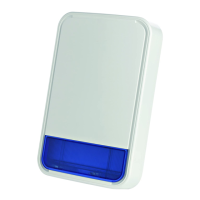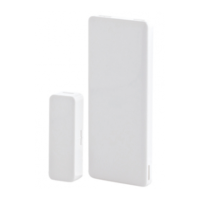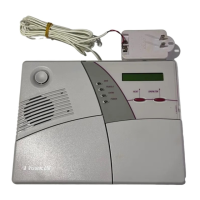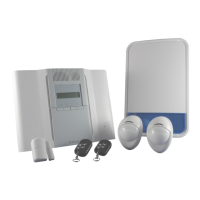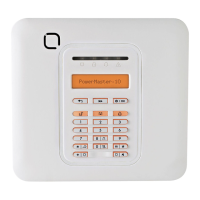DE5110 19
Figure 8.1 Keypad Chaining Method
7HFKQLFDO 'DWD
The wire gauges available for laying out the bus are given below:
AWG Resistance Reference No.*
Number
Diameter per meter For meters For feet
24 0.5 mm 0.085
Ω
21,000 68,900
22 0.65 mm 0.053
Ω
35,000 114,800
20 0.8 mm 0.033
Ω
56,000 183,740
18 1.0 mm 0.021
Ω
88,000 288,720
16 1.3 mm 0.013
Ω
142,000 465,900
∗
If you use the calculating method given in Para. 8.3 below, this
number will help you determine whether the wire you intend to
use will not cause an excessive voltage drop.
The current drawn by the various keypads and zone expander are:
Unit Current (mA) Unit Current (mA)
KP-1001 35 mA KP-1003 60 Ma
KP-1002 45 mA EXP-1600 15 mA
&DOFXODWLQJ 0HWKRG
Suppose you intend to use AWG 24 wires in the case presented in
Fig. 8.1, and you wish to verify that this wire gauge will do.
A .
Multiply the distance of each unit on the bus by the current
drain (in mA) of that unit, as done in the following table (you
may use meters or feet, as desired). When done, sum up all
products of all multiplication made. The results are shown as
"total" for both meters and feet.
Unit Current Distance Current x Distance
(mA) Meters Feet for meters for feet
KP-1003 60 12 40 720 2,400
KP-1002 45 35 115 1,575 5,175
KP-1002 45 70 230 3,150 10,350
EXP-1600 15 90 295 1,350 4,425
KP-1001 35 105 345 3,675 12,075
Total: 10,470 34,425
B.
At this stage, all you have to do is compare the computed total
with the reference number pertaining to AWG24 in the wire
data table (Para. 8.2). The reference numbers are
21,000
(for
meters) and
68,900
(for feet).
•
If the number you computed is
smaller than or equal to
the
reference number, then AWG24 wires are suitable for this
application.
•
If the number you computed is
larger than the reference
number
, then you should consider using a smaller AWG
number (larger diameter cable).
NOTES:
1.
If various detectors draw current from the distant expander, the
calculation in A above must include them as well, in
accordance with their individual distances from the alarm
control module and their individual current consumption.
2.
Once the installation work is done, it is recommended to
measure the voltage at the end of the line, to verify that the last
unit does not receive less than 10 volts DC (while the AC
supply is normal).
3.
If several keypad buses are branched out in parallel or in
different directions from the alarm control module, each bus
must be treated separately.
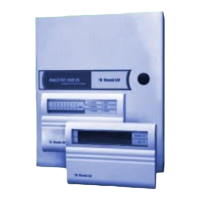
